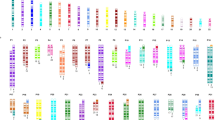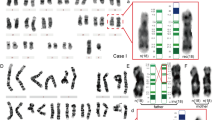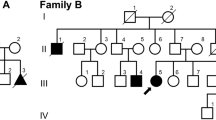Abstract
Unbalanced translocations, that involve the proximal chromosome 15 long arm and the telomeric region of a partner chromosome, result in a karyotype of 45 chromosomes with monosomy of the proximal 15q imprinted region. Here, we present our analysis of eight such unbalanced translocations that, depending on the parental origin of the rearranged chromosome, were associated with either Prader–Willi or Angelman syndrome. First, using FISH with specific BAC clones, we characterized the chromosome 15 breakpoint of each translocation and demonstrate that four of them are clustered in a small 460 kb interval located in the proximal 15q14 band. Second, analyzing the sequence of this region, we demonstrate the proximity of a low-copy repeat 15 (LCR15)-duplicon element that is known to facilitate recombination events at meiosis and to promote rearrangements. The presence, in this region, of both a cluster of translocation breakpoints and a LCR15-duplicon element defines a new breakpoint cluster (BP6), which, to our knowledge, is the most distal breakpoint cluster described in proximal 15q. Third, we demonstrate that the breakpoints for other rearrangements including large inv dup (15) chromosomes do not map to BP6, suggesting that it is specific to translocations. Finally, the translocation breakpoints located within BP6 result in very large proximal 15q deletions providing new informative genotype–phenotype correlations.
Similar content being viewed by others
Log in or create a free account to read this content
Gain free access to this article, as well as selected content from this journal and more on nature.com
or
References
Knoll JH, Nicholls RD, Magenis RE, Graham Jr JM, Lalande M, Latt SA : Angelman and Prader–Willi syndromes share a common chromosome 15 deletion but differ in parental origin of the deletion. Am J Med Genet 1989; 32: 285–290.
Robinson WP, Bottani A, Xie YG et al: Molecular, cytogenetic, and clinical investigations of Prader–Willi syndrome patients. Am J Hum Genet 1991; 49: 1219–1234.
Bundey S, Hardy C, Vickers S, Kilpatrick MW, Corbett JA : Duplication of the 15q11-13 region in a patient with autism, epilepsy and ataxia. Dev Med Child Neurol 1994; 36: 736–742.
Browne CE, Dennis NR, Maher E et al: Inherited interstitial duplications of proximal 15q: genotype–phenotype correlations. Am J Hum Genet 1997; 61: 1342–1352.
Cook Jr EH, Lindgren V, Leventhal BL et al: Autism or atypical autism in maternally but not paternally derived proximal 15q duplication. Am J Hum Genet 1997; 60: 928–934.
Repetto GM, White LM, Bader PJ, Johnson D, Knoll JH : Interstitial duplications of chromosome region 15q11q13: clinical and molecular characterization. Am J Med Genet 1998; 79: 82–89.
Robinson WP, Binkert F, Gine R et al: Clinical and molecular analysis of five inv dup(15) patients. Eur J Hum Genet 1993; 1: 37–50.
Webb T : Inv dup(15) supernumerary marker chromosomes. J Med Genet 1994; 31: 585–594.
Mignon C, Malzac P, Moncla A et al: Clinical heterogeneity in 16 patients with inv dup 15 chromosome: cytogenetic and molecular studies, search for an imprinting effect. Eur J Hum Genet 1996; 4: 88–100.
Wandstrat AE, Schwartz S : Isolation and molecular analysis of inv dup(15) and construction of a physical map of a common breakpoint in order to elucidate their mechanism of formation. Chromosoma 2000; 109: 498–505.
Schinzel AA, Brecevic L, Bernasconi F et al: Intrachromosomal triplication of 15q11-q13. J Med Genet 1994; 31: 798–803.
Ungaro P, Christian SL, Fantes JA et al: Molecular characterisation of four cases of intrachromosomal triplication of chromosome 15q11-q14. J Med Genet 2001; 38: 26–34.
Vialard F, Mignon-Ravix C, Parain D et al: Mechanism of intrachromosomal triplications 15q11–q13: a new clinical report. Am J Med Genet 2003; 118: 229–234.
Rivera H, Zuffardi O, Gargantini L : Nonreciprocal and jumping translocations of 15q1-qter in Prader–Willi syndrome. Am J Med Genet 1990; 37: 311–317.
Jauch A, Robson L, Smith A : Investigations with fluorescence in situ hybridization (FISH) demonstrate loss of the telomeres on the reciprocal chromosome in three unbalanced translocations involving chromosome 15 in the Prader–Willi and Angelman syndromes. Hum Genet 1995; 96: 345–349.
Rossi E, Floridia G, Casali M et al: Types, stability, and phenotypic consequences of chromosome rearrangements leading to interstitial telomeric sequences. J Med Genet 1993; 30: 926–931.
Wenger SL, Sell SL, Painter MJ, Steele MW : Inherited unbalanced subtelomeric translocation in a child with 8p- and Angelman syndromes. Am J Med Genet 1997; 70: 150–154.
Pujana MA, Nadal M, Guitart M, Armengol L, Gratacos M, Estivill X : Human chromosome 15q11–q14 regions of rearrangements contain clusters of LCR15 duplicons. Eur J Hum Genet 2002; 10: 26–35.
Amos-Landgraf JM, Ji Y, Gottlieb W et al: Chromosome breakage in the Prader–Willi and Angelman syndromes involves recombination between large, transcribed repeats at proximal and distal breakpoints. Am J Hum Genet 1999; 65: 370–386.
Christian SL, Fantes JA, Mewborn SK, Huang B, Ledbetter DH : Large genomic duplicons map to sites of instability in the Prader–Willi/Angelman syndrome chromosome region (15q11-q13). Hum Mol Genet 1999; 8: 1025–1037.
Windpassinger C, Petek E, Wagner K, Langmann A, Buiting K, Kroisel PM : Molecular characterization of a unique de novo 15q deletion associated with Prader–Willi syndrome and central visual impairment. Clin Genet 2003; 63: 297–302.
Krajewska-Walasek M, Gutkowska A, Bielinska B, Goryluk-Kozakiewicz B, Popowska E : A case of Prader–Willi syndrome arising as a result of familial unbalanced translocation t(11;15)(q25;q13). Clin Genet 1998; 54: 60–64.
Cuoco C, Bicocchi MP, Granata D, Mezzano P, Serra G : De novo (15;21) unbalanced translocation of paternal origin in a girl with Prader–Willi syndrome. Am J Med Genet 1990; 37: 62–64.
Flint J, Bates GP, Clark K et al: Sequence comparison of human and yeast telomeres identifies structurally distinct subtelomeric domains. Hum Mol Genet 1997; 6: 1305–1313.
Murray J, Buard J, Neil DL et al: Comparative sequence analysis of human minisatellites showing meiotic repeat instability. Genome Res 1999; 9: 130–136.
Iyer V, Struhl K : Poly(dA:dT), a ubiquitous promoter element that stimulates transcription via its intrinsic DNA structure. EMBO J 1995; 14: 2570–2579.
Rouquier S, Taviaux S, Trask BJ et al: Distribution of olfactory receptor genes in the human genome. Nat Genet 1998; 18: 243–250.
Shaw CJ, Lupski JR : Implications of human genome architecture for rearrangement-based disorders: the genomic basis of disease. Hum Mol Genet 2004; 13: R57–R64.
Knoll JH, Nicholls RD, Magenis RE et al: Angelman syndrome: three molecular classes identified with chromosome 15q11q13-specific DNA markers. Am J Hum Genet 1990; 47: 149–155.
Christian SL, Robinson WP, Huang B et al: Molecular characterization of two proximal deletion breakpoint regions in both Prader–Willi and Angelman syndrome patients. Am J Hum Genet 1995; 57: 40–48.
Roberts SE, Dennis NR, Browne CE et al: Characterisation of interstitial duplications and triplications of chromosome 15q11–q13. Hum Genet 2002; 110: 227–234.
Huang B, Crolla JA, Christian SL et al: Refined molecular characterization of the breakpoints in small inv dup(15) chromosomes. Hum Genet 1997; 99: 11–17.
Wandstrat AE, Leana-Cox J, Jenkins L, Schwartz S : Molecular cytogenetic evidence for a common breakpoint in the largest inverted duplications of chromosome 15. Am J Hum Genet 1998; 62: 925–936.
Robinson WP, Dutly F, Nicholls RD et al: The mechanisms involved in formation of deletions and duplications of 15q11–q13. J Med Genet 1998; 35: 130–136.
Ji Y, Eichler EE, Schwartz S, Nicholls RD : Structure of chromosomal duplicons and their role in mediating human genomic disorders. Genome Res 2000; 10: 597–610.
Spiteri E, Babcock M, Kashork CD et al: Frequent translocations occur between low copy repeats on chromosome 22q11.2 (LCR22 s) and telomeric bands of partner chromosomes. Hum Mol Genet 2003; 12: 1823–1837.
Borgaonkar DS, Ebenezer L, Scott Jr CI, Golomb HM, Bahr GF : Identification of a D–E(15–18) translocation chromosome by quinacrine fluorescence and urea banding techniques. Humangenetik 1973; 17: 317–321.
Ming PM, Goodner DM, Park TS : Chromosome 6/15 translocation with multiple congenital anomalies. Obstet Gynecol 1977; 49: 251–253.
Kawashima H, Fujita H, Sakamamoto Y, Hamamoto Y : An extra idic(15p)(q11) chromosome in Prader–Willi syndrome. Humangenet 1980, Cited as personal communication in: 55: 409–411.
Duckett DP, Roberts SH : Adjacent 2 meiotic disjunction. Report of a case resulting from a familial 13q;15q balanced reciprocal translocation and review of the literature. Hum Genet 1981; 58: 377–386.
Pauli RM, Meisner LF, Szmanda RJ : ‘Expanded’ Prader–Willi syndrome in a boy with an unusual 15q chromosome deletion. Am J Dis Child 1983; 137: 1087–1089.
Schwartz S, Max SR, Panny SR, Cohen MM : Deletions of proximal 15q and non-classical Prader–Willi syndrome phenotypes. Am J Med Genet 1985; 20: 255–263.
Smith A, Jauch A, St Heaps L, Robson L, Kearney B : Unbalanced translocation t(15;22) in ‘severe’ Prader–Willi syndrome. Ann Genet 2000; 43: 125–130.
Varela MC, Lopes GMP, Koiffmann CP : Prader–Willi syndrome with an unusually large 15q deletion due to an unbalanced translocation t(4;15). Ann Genet 2004; 47: 267–273.
Herva R, Vuorinen O : Congenital heart disease with del(15q) mosaicism. Clin Genet 1980; 17: 26–28.
Galan F, Aguilar MS, Gonzales J et al: Interstitial 15q deletion without a classic Prader–Willi syndrome. Am J Med Genet 1991; 38: 532–534.
Acknowledgements
The present work has been focused on unbalanced translocations involving chr 15q and the telomeric band of the partner chromosome. However, the authors would like to thank the members of the ACLF (Association des Cytogeneticiens de Langue Française) and the ECA (European Cytogeneticists Association) that kindly participate to this study by sending cytogenetic material: Drs G Bourrouillou (Toulouse, France); K Devriendt (Leuven, Belgique); A-M Frances (Toulon, France); B de Fréminville (St Etienne, France); E Gautier (Paris, France); H Journel (Vannes, France); N Joyé (Paris, France); P Kleinfinger (Cergy-Pontoise, France); J Lespinasse (Chambéry, France); D Martin-Coignard (Le Mans, France); K Miller (Hannover, Germany); H Moirot (Rouen, France); M Syrrou (Ionnanina, Greece); F Stipoljev (Zagreb, Croatie); H Stora de Novion (Nice, France); S Szpiro-Tapia (Cergy-Pontoise, France); L Taine (Bordeaux, France); and K Wagner (Graz, Austria). This work was supported by grants from the ARC (Association pour la Recherche contre le Cancer), INSERM and the Ministère de l'Enseignement et de la Recherche.
Author information
Authors and Affiliations
Corresponding author
Rights and permissions
About this article
Cite this article
Mignon-Ravix, C., Depetris, D., Luciani, J. et al. Recurrent rearrangements in the proximal 15q11–q14 region: a new breakpoint cluster specific to unbalanced translocations. Eur J Hum Genet 15, 432–440 (2007). https://doi.org/10.1038/sj.ejhg.5201775
Received:
Revised:
Accepted:
Published:
Issue date:
DOI: https://doi.org/10.1038/sj.ejhg.5201775
Keywords
This article is cited by
-
Prader-Willi syndrome - type 1 deletion, a consequence of an unbalanced translocation of chromosomes 13 and 15, easily to be mixed up with a Robertsonian translocation
Molecular Cytogenetics (2015)
-
A study of two Chinese patients with tetrasomy and pentasomy 15q11q13 including Prader-Willi/Angelman syndrome critical region present with developmental delays and mental impairment
BMC Medical Genetics (2013)
-
Unique and atypical deletions in Prader–Willi syndrome reveal distinct phenotypes
European Journal of Human Genetics (2012)
-
Copy Number Variants: A New Molecular Frontier in Clinical Psychiatry
Current Psychiatry Reports (2011)



